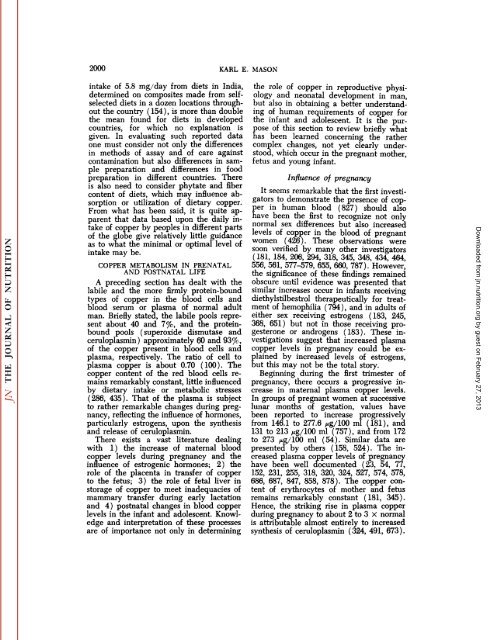conspectus of researchon copper metabolism and requirements
conspectus of researchon copper metabolism and requirements
conspectus of researchon copper metabolism and requirements
Create successful ePaper yourself
Turn your PDF publications into a flip-book with our unique Google optimized e-Paper software.
2000 KARL E. MASON<br />
intake <strong>of</strong> 5.8 mg/ day from diets in India,<br />
determined on composites made from selfselected<br />
diets in a dozen locations through<br />
out the country ( 154), is more than double<br />
the mean found for diets in developed<br />
countries, for which no explanation is<br />
given. In evaluating such reported data<br />
one must consider not only the differences<br />
in methods <strong>of</strong> assay <strong>and</strong> <strong>of</strong> care against<br />
contamination but also differences in sam<br />
ple preparation <strong>and</strong> differences in food<br />
preparation in different countries. There<br />
is also need to consider phytate <strong>and</strong> fiber<br />
content <strong>of</strong> diets, which may influence ab<br />
sorption or utilization <strong>of</strong> dietary <strong>copper</strong>.<br />
From what has been said, it is quite ap<br />
parent that data based upon the daily in<br />
take <strong>of</strong> <strong>copper</strong> by peoples in different parts<br />
<strong>of</strong> the globe give relatively little guidance<br />
as to what the minimal or optimal level <strong>of</strong><br />
intake may be.<br />
COPPER METABOLISM IN PRENATAL<br />
AND POSTNATAL LIFE<br />
A preceding section has dealt with the<br />
labile <strong>and</strong> the more firmly protein-bound<br />
types <strong>of</strong> <strong>copper</strong> in the blood cells <strong>and</strong><br />
blood serum or plasma <strong>of</strong> normal adult<br />
man. Briefly stated, the labile pools repre<br />
sent about 40 <strong>and</strong> 1%, <strong>and</strong> the proteinbound<br />
pools (superoxide dismutase <strong>and</strong><br />
ceruloplasmin ) approximately 60 <strong>and</strong> 93$,<br />
<strong>of</strong> the <strong>copper</strong> present in blood cells <strong>and</strong><br />
plasma, respectively. The ratio <strong>of</strong> cell to<br />
plasma <strong>copper</strong> is about 0.70 ( 100). The<br />
<strong>copper</strong> content <strong>of</strong> the red blood cells re<br />
mains remarkably constant, little influenced<br />
by dietary intake or metabolic stresses<br />
(286, 435). That <strong>of</strong> the plasma is subject<br />
to rather remarkable changes during preg<br />
nancy, reflecting the influence <strong>of</strong> hormones,<br />
particularly estrogens, upon the synthesis<br />
<strong>and</strong> release <strong>of</strong> ceruloplasmin.<br />
There exists a vast literature dealing<br />
with 1) the increase <strong>of</strong> maternal blood<br />
<strong>copper</strong> levels during pregnancy <strong>and</strong> the<br />
influence <strong>of</strong> estrogenic hormones; 2) the<br />
role <strong>of</strong> the placenta in transfer <strong>of</strong> <strong>copper</strong><br />
to the fetus; 3) the role <strong>of</strong> fetal liver in<br />
storage <strong>of</strong> <strong>copper</strong> to meet inadequacies <strong>of</strong><br />
mammary transfer during early lactation<br />
<strong>and</strong> 4) postnatal changes in blood <strong>copper</strong><br />
levels in the infant <strong>and</strong> adolescent. Knowl<br />
edge <strong>and</strong> interpretation <strong>of</strong> these processes<br />
are <strong>of</strong> importance not only in determining<br />
the role <strong>of</strong> <strong>copper</strong> in reproductive physi<br />
ology <strong>and</strong> neonatal development in man,<br />
but also in obtaining a better underst<strong>and</strong><br />
ing <strong>of</strong> human <strong>requirements</strong> <strong>of</strong> <strong>copper</strong> for<br />
the infant <strong>and</strong> adolescent. It is the pur<br />
pose <strong>of</strong> this section to review briefly what<br />
has been learned concerning the rather<br />
complex changes, not yet clearly under<br />
stood, which occur in the pregnant mother,<br />
fetus <strong>and</strong> young infant.<br />
Influence <strong>of</strong> pregnancy<br />
It seems remarkable that the first investi<br />
gators to demonstrate the presence <strong>of</strong> cop<br />
per in human blood (827) should also<br />
have been the first to recognize not only<br />
normal sex differences but also increased<br />
levels <strong>of</strong> <strong>copper</strong> in the blood <strong>of</strong> pregnant<br />
women (426). These observations were<br />
soon verified by many other investigators<br />
( 181, 184, 206, 294, 318, 345, 348, 434, 464,<br />
556, 561, 577-579, 655, 660, 787). However,<br />
the significance <strong>of</strong> these findings remained<br />
obscure until evidence was presented that<br />
similar increases occur in infants receiving<br />
diethylstilbestrol therapeutically for treat<br />
ment <strong>of</strong> hemophilia (794), <strong>and</strong> in adults <strong>of</strong><br />
either sex receiving estrogens (183, 245,<br />
368, 651) but not in those receiving pro<br />
gesterone or <strong>and</strong>rogens (183). These in<br />
vestigations suggest that increased plasma<br />
<strong>copper</strong> levels in pregnancy could be ex<br />
plained by increased levels <strong>of</strong> estrogens,<br />
but this may not be the total story.<br />
Beginning during the first trimester <strong>of</strong><br />
pregnancy, there occurs a progressive in<br />
crease in maternal plasma <strong>copper</strong> levels.<br />
In groups <strong>of</strong> pregnant women at successive<br />
lunar months <strong>of</strong> gestation, values have<br />
been reported to increase progressively<br />
from 146.1 to 277.6 jig/100 ml (181), <strong>and</strong><br />
131 to 213 Mg/100 ml (757), <strong>and</strong> from 172<br />
to 273 /ig/100 ml (54). Similar data are<br />
presented by others (158, 524). The in<br />
creased plasma <strong>copper</strong> levels <strong>of</strong> pregnancy<br />
have been well documented (23, 54, 77,<br />
152, 231, 255, 318, 320, 324, 527, 574, 578,<br />
686, 687, 847, 858, 878). The <strong>copper</strong> con<br />
tent <strong>of</strong> erythrocytes <strong>of</strong> mother <strong>and</strong> fetus<br />
remains remarkably constant ( 181, 345 ).<br />
Hence, the striking rise in plasma <strong>copper</strong><br />
during pregnancy to about 2 to 3 X normal<br />
is attributable almost entirely to increased<br />
synthesis <strong>of</strong> ceruloplasmin (324, 491, 673).<br />
Downloaded from<br />
jn.nutrition.org<br />
by guest on February 27, 2013
















